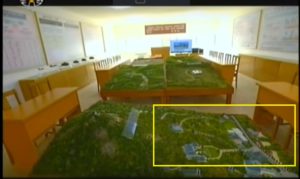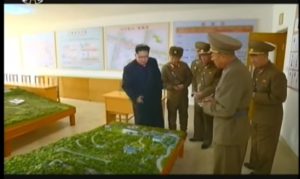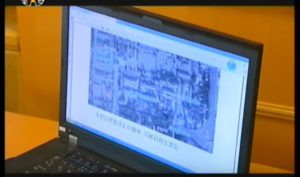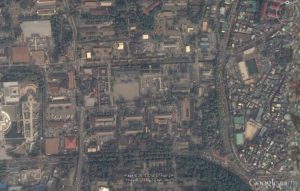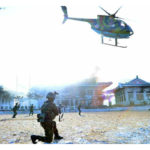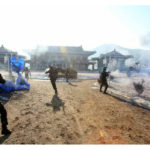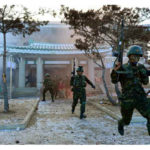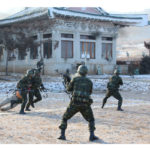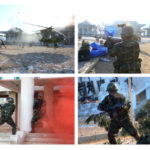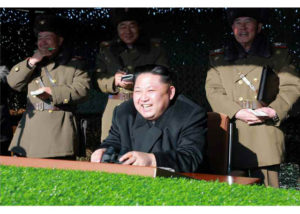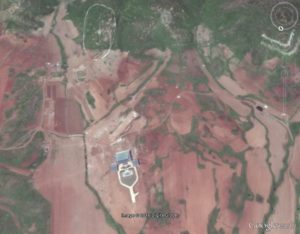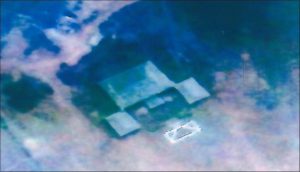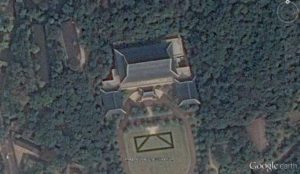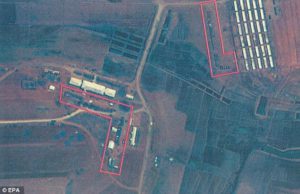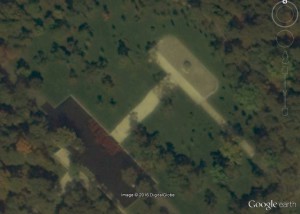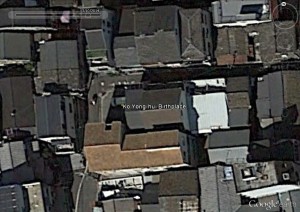UPDATE 7 (2016-5-12): Yonhap offers some postmortem statistics on the Kaesong Industrial Complex:
The total value of products churned out from the Kaesong Industrial Complex in North Korea reached US$3.23 billion in the 11 years of its operations before it was shut down earlier this year, a report by South Korea’s unification ministry said Thursday.
The joint factory park that began production in 2005 as part of a deal reached between the leaders of the two countries in June 2000, had been the last remaining economic link between the two countries. On Feb. 10, Seoul announced the closure of the joint venture as punishment for North Korea’s defiant nuclear test in January and a long-range rocket launch in February.
The ministry’s white paper said in 2015, the annual production volume reached its peak at $563.3 million. Last year also marked the first time yearly production numbers exceeded the $500 million threshold, data showed.
In the first year of operations in 2005, the corresponding number stood at $14.9 million before it grew steadily to $323.3 million in 2010 and $469.5 million in 2012, according to the findings.
A four-month suspension of operations, amid escalating inter-Korean tensions, caused annual production to drop to $223.8 million in 2013 before numbers rebounded to $470 million the following year.
As of the end of 2015, a total of 54,988 North Koreans were employed at the factory park designed to combine South Korea’s capital and the North’s cheap labor force. The numbers marked a growth of more than 1,000 workers from a year earlier.
Spurred by last year’s biggest-ever production at the factory, trade volume between the South and the North reached $2.71 billion, the highest figure recorded to date, the white paper also showed.
The brisk performance helped push up the number of travelers between the countries in 2015, with the figure rising to an eight-year high of 132,101.
The unification ministry’s report then said South Korea’s humanitarian assistance to the North soared to a six-year high of 25.4 billion won (US$21.8 million) in 2015.
In the same year, the number of North Koreans defecting to the South reached 1,276 last year, the smallest tally since 2001 when the figure stood at 1,043, according to the ministry.
The annual addition of North Korean defectors took the total population of North Korean defectors in South Korea up to 28,795 as of the end of last year, with about 70 percent of them being women.
“Based on the principle of maintaining solid security, the government has strived to normalize South-North relations and bring about peace on the Korean Peninsula,” the ministry said in assessment of its performance in 2015.
“The government is keeping the Kaesong factory park venture closed and taking stringent sanctions in collaboration with the international community,” the ministry said, denouncing North Korea’s defiant nuclear test in January that was followed by numerous military threats.
UPDATE 6 (2016-2-24): Korean firms claim huge losses from factory shutdown. According to Yonhap:
South Korean firms based in a jointly run industrial park in a North Korean border city have suffered more than 815 billion won (US$660 million) in losses from its shutdown, their association claimed Wednesday.
Earlier this month, North Korea expelled South Korean workers from the Kaesong Industrial Complex and froze the assets of companies operating there, a day after the South suspended operations in retaliation for Pyongyang’s rocket launch.
The shutdown of the industrial park, regarded as the top achievement of inter-Korean reconciliation and cooperation efforts, is feared to deal a heavy blow to the South Korean firms involved.
A total of 124 South Korean companies have been operating in the zone, some 50 kilometers northwest of Seoul, employing more than 54,000 North Korean workers to produce labor-intensive goods, such as clothes and utensils.
The estimated financial damage breaks down to some 569 billion won in investment and facilities, and some 245 billion won in inventory.
The association said any potential losses stemming from compensation to their customers and the stoppage of their operations was not included in the tally.
According to the association, 49 companies largely rely on their factories in the industrial park for their production. “Actual damage should be counted more accurately, and will be revealed later,” it said.
South Korean companies at the inter-Korean industrial park have been urging their government to roll out full support measures as their losses from the park’s shutdown are unimaginable.
When the industrial park was closed in 2013 for 160 days, South Korean firms reported a combined loss of 1.05 trillion won.
The companies, however, claim the actual damage will be greater considering the loss of business partners and credibility.
“We strongly demand that the government fully compensate our losses in investment and other assets as insurance coverage is very limited,” it said.
In order to minimize South Korean firms’ possible losses, the country’s financial regulator earlier said it would provide financial aid to the firms operating there.
The complex, which opened in 2004, had served as a major revenue source for the cash-strapped North, while South Korea had benefited from cheap but skilled North Korean labor.
The complex had been recognized as an exception to Seoul’s sanctions against Pyongyang designed to punish it for the sinking of a South Korean warship in 2010.
UPDATE 5 (2016-2-12): Seoul cuts off power supplies to factory park in North Korea (AP)
South Korea has cut off power and water supplies to a factory park in North Korea, officials said Friday, a day after the North deported all South Korean workers there and ordered a military takeover of the complex that had been the last major symbol of cooperation between the rivals.
UPDATE 4 (2016-2-11): NK Leadership Watch posts CPRK statement.
UPDATE 3 (2016-2-11): North Korea freezes Gaeseong assets, expels South Korean workers (Korea Herald)
At about 10 p.m., the South Korean government confirmed that all of the 280 South Korean workers who had been at the facility returned home safely.
“The frozen equipment, materials and products will be managed by the committee of Gaeseong people,” Pyongyang’s statement said prior to the workers’ return to South Korea.
“From 10 p.m. (10:30 p.m., South Korean time) on Feb. 11, (the North) will seal off the industrial park and nearby military demarcation line, shut the western overland route and declare the park as a military off-limit zone.”
…
The South Korean firms operating in the complex sent one truck each to Gaeseong to bring to the South their finished products, production materials, equipment and other belongings, while Seoul authorities vowed to try their utmost to minimize possible damages to firms.
An additional 130 South Koreans entered the complex to prepare for the suspension of factory operations. There were 70 more South Koreans in the park from the previous day as more workers were sent to carry out the government’s withdrawal instructions.
Apparently in line with Pyongyang’s instructions, North Korean workers did not show up at the park, Seoul officials said. Some 55,000 North Korean workers worked at the complex through which Pyongyang raked in around $100 million annually.
UPDATE 2 (2016-2-11): North Korea to Freeze South’s Assets at Kaesong Industrial Park (New York Times)
North Korea said on Thursday that it would freeze all South Korean assets at a joint industrial complex the South shut down to retaliate for a recent nuclear test and a rocket launch by the North.
It also ordered all 248 South Korean managers in the factory park in the North Korean town of Kaesong expelled by 5 p.m. on Thursday, allowing them to return home with only their personal belongings. The North said it would sever all communication across the border after the last of the South Koreans left.
In addition, it said it was shutting down the only cross-border highway open between the two Koreas. The road has linked South Korea with the factory park since 2004, when it began operations just over the western inter-Korean border. The zone will return to the control of the North Korean military, it said.
…
South Korea’s action was “a declaration of an end to the last lifeline of the North-South relations” and “driving the situation in the Korean Peninsula to the brink of a war,” said a statement from the Committee for the Peaceful Reunification of Korea, a North Korean government agency in charge of relations with the South.
“The South Korean puppet group will experience what disastrous and painful consequences will be entailed by its action,” it said, calling the South Korean president, Park Geun-hye, “a traitor for all ages.”
…
The corridor linking Kaesong and Seoul, the South Korean capital, was the main invasion route for North Korean troops during the 1950-53 Korean War and was at one time the most heavily guarded section of the 155-mile border.
After a historic inter-Korean summit meeting in 2000 in which the two sides agreed to promote reconciliation, the hard-line North Korean People’s Army grudgingly stepped aside as South Korean engineers removed barbed-wire fences, tank traps and minefields to build the highway across the border.
The Kaesong complex began as a pilot project to combine South Korean manufacturing skills with cheap North Korean labor. Eventually, more than 45,000 North Koreans worked for 123 South Korean-owned factories there. The plants produced more than $515 million worth of textiles, electronic parts and other labor-intensive goods last year, according to the South Korean government.
UPDATE 1 (2016-2-10): South Korea Takes a Stand, Closes Kaesong Industrial Complex (RFA)
Until Wednesday, Kaesong was one of the few instances where the two countries cooperate.
Established in 2004, the industrial park is the last remnant of former South Korean President Kim Dae-Jung’s Sunshine Policy, which also led to a historic summit with then-North Korean leader Kim Jong Il in 2000.
While Kim was awarded the Nobel Peace Prize for implementing the Sunshine Policy, his legacy was dismantled in 2010 when South Korea’s Unification Ministry declared the policy a failure.
Closing Kaesong now snuffs out what remains of North-South cooperation and closes a window through which some North Koreans could get a taste of life in the south, Lankov said.
“I have supported the continued operation of the Kaesong complex because of the enormous effects of South Korean Choco Pie cookies on the North Korean workers, which the North Korean regime banned distribution of some time ago,” Lankov said.
“The Kaesong Industrial Complex has served as sort of a window through which its North Korean workers can get a glimpse of life in South Korea,” he added.
Labeled a special administrative industrial region of North Korea, Kaesong operated as a collaborative economic development zone that hosts South Korean companies attracted by its access to cheap labor. Kaesong is only six miles inside North Korea, with direct rail and highway access to the south.
The industrial park has been controversial in South Korea, as some conservative South Koreans argue that it extends a lifeline to the North Korean leadership, undermining United Nations sanctions.
Kaesong has been closed before.
In 2013, North Korea pulled its 53,000 workers from the plant in a show of strength during an earlier time of rising tensions between the two nations. At the time, North Korea said it “gets few economic benefits from the zone while the South side largely benefits from it.”
While the earlier closure did not last, the closure announced Wednesday looks set to become permanent.
ORIGINAL POST: Here is a statement from the Ministry of Unification:
Government Statement regarding the Complete Shutdown of the Gaeseong Industrial Complex
North Korea has pushed ahead with the extremely provocative act of launching a long-range missile on the heels of its 4th nuclear test, showing disregard for the repeated warnings of the international community and the suffering of its people.
North Korea’s provocations are a direct challenge to peace and stability on the Korean Peninsula and in the international community and its actions are absolutely unacceptable. Notwithstanding international efforts to deter North Korea from developing its nuclear capabilities and long-range missiles,
North Korea has declared that it would follow up on its recent provocations with additional nuclear tests and missile launches, thereby not even showing the slightest intent to forgo the development of its nuclear and missile capabilities.
The status quo is not static, as North Korea’s nuclear capabilities will be upgraded, all but leading to a catastrophic disaster. If left unattended, North Korea’s nuclear and missile development will lead to a fundamental imbalance in and threat to the security landscape of Northeast Asia, not to mention the Korean Peninsula, and the countries of this region will be left with no choice but to take measures to ensure their own survival and shore up their security, and there are concerns that this could eventually even lead to a nuclear domino effect.
Under these grave circumstances, it is clear that the existing approach will not work in discomfiting North Korea’s nuclear and missile development plans. Accordingly, what is in order is a vigorous response together with the international community that, for sure, exacts a price for North Korea’s misguided actions, as well as extraordinary measures that compel North Korea to give up its nuclear capabilities and change its ways.
At a time when the international community is seeking sanctions in the wake of North Korea’s violation of UN Security Council resolutions with its nuclear test and long-range missile launch, there is a need for Korea, as a key party, to show leadership in taking part in these moves.
Over the years, our Government has been working to continue maintaining the Gaeseong Industrial Complex despite North Korea’s repeated provocations and under extreme state of affairs, all with a view to assisting the lives of the North Korean people, providing impetus to lifting up the North Korean economy, and achieving the shared progress for both South and North Korea. We have also made every effort to move the Gaeseong Industrial Complex forward under the position that it should be developed in conformity with international norms.
However, such assistance and the efforts of our Government have ultimately been wrongly harnessed in the service of upgrading North Korea’s nuclear weapons and long-range missiles.
To date, the total amount of cash that flowed into North Korea through the Gaeseong Industrial Complex is 616 billion won (560 million dollars), with 132 billion won (120 million dollars) in cash having flowed into North Korea last year alone, and the Government and the private sector have invested a total of 1.019 trillion won. It appears that such funds have not been used to pave the way to peace as the international community had hoped, but rather to upgrade its nuclear weapons and long-range missiles.
This tramples on the efforts of the Korean Government and the 124 businesses that have set up shop in the Gaeseong Industrial Complex, and puts at risk the lives and safety of the Korean people.
Today, in order to stop funds of the Gaeoseong Industrial Complex from being used to support the development of North Korea’s nuclear and missile capabilities, and to prevent our businesses from suffering, the Government has decided to completely shut down the Gaeseong Industrial Complex.
We have notified the North Korean authorities of this decision and called on them to extend such cooperation as is rendered necessary by the complete shutdown of the Gaeseong Industrial Complex, including the safe return of our citizens.
The Government will move expeditiously forward with all steps to ensure the safe return of our citizens, and will set up a Government Task Force under the Office for Government Policy Coordination to provide the necessary whole-of-government assistance to our businesses.
We ask for the full understanding of our people that the Government’s complete shutdown of the Gaeseong Industrial Complex is an unavoidable decision, which takes into account the seriousness of the situation on the Korean Peninsula, and we call upon the people to stand with us as we seek to overcome such challenges.
